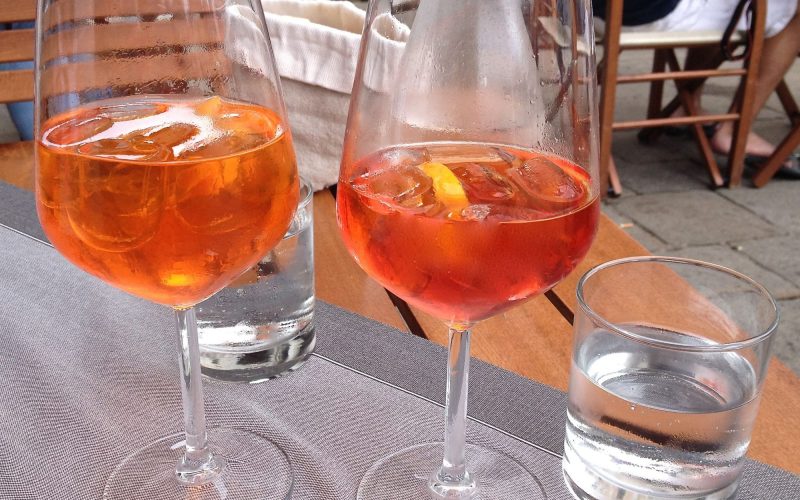Italy is usually known for its history, landmarks, fashion, Italian foods, and culture. However, it is also home to some of the world’s favorite alcoholic drinks.
Italy’s deep sense of fashion and design suited classic drinks and cocktails in the early fifties. Italian bartenders and notable drinkers left their legacy in the world.
Moreover, there is no better way to indulge in exquisite cuisine than to eat your food with an equally fantastic beverage.
This led to the innovation of alcoholic Italian drinks and drinks. This article will discuss some of these drinks and beverages;
1. Americano
Americano is popularly known as the father of Negroni. Besides, it shares the same ingredients as the Negroni except for gin.
Americano was formerly called Milano-Torino by the producers because of the use of Campari and vermouth. It was originated from Milan and Turin.
Milano-Torino’s name was changed to Americano in memory of boxer Primo Carnera’s victory in New York in the 1930s.
Also, a fun fact: James Bond ordered Americano in Ian Fleming’s novel Casino Royale. Furthermore, 5/10 Vermouth Rosso, 5/10 Bitter Campari, and soda water are required to make americano.
The drink is poured and stirred directly into an ice-filled glass, then topped up with soda water and a slice of orange.
2. Negroni
Negroni is one of the most famous alcoholic Italian drinks. Its name comes from Count Camillo Negroni, a traveler who lived in Florence in the 1920s.
There are different variations on how Negroni came about. One is that Camillo went to his usual bar in London and asked for a regular drink served slightly differently.
He used a slice of orange instead of the typical lemon. In addition, the Negroni family started a distillery that makes a readily mixed version of Negroni called Antico Negroni.
Furthermore, in the making, Negroni, 1/3 Vermouth Rosso, 1/3 Dry Gin, and 1/3 bitter Campari are served in a medium tumbler or old-fashioned glass on the rocks.
Like an Americano, the ingredients are stirred directly into the glass with half a slice of orange and lemon peel.
3. Bellini
Bellini is named after the 15th-century artist Giovanni Bellini. Bellini was created in 1948 in Venice when Guiseppe Cipriani, the owner of Harry’s Bar, launched an exhibition in Giovanni’s memory.
The drink was for the occasion and soon gained recognition worldwide. In addition, the signature pink look of the glass was inspired by a pink vest worn by a monk in one of Giovanni’s paintings.
Furthermore, in preparing 3/10, Nettare di Pesca (peach juice) and 7/10 Spumante Brut were used. The drink is built directly in a champagne flute, with the peach juice poured in first.
4. Rossini
Rossini is an alcoholic Italian drink that can be drunk at any time of the day. Bellini’s variation uses 3/10 Nettare di fragole (strawberry juice) and 7/10 Spumante Brut to prepare.
Other variations include a mimosa made with orange and brut, Puccini made with mandarin and brut, and, lastly, il Tiziano, strawberry grapes, and Brut.
5. Aperitivo
Aperitivo, also called a martini cocktail, is served before dinner to help prepare the digestive system. Most Italians see this drink as a tradition before eating their dinner.
It is better for the digestive system than overly sweetened cocktails. Some of the variations are perfect martinis, vodka martinis, Gibson, sweet martinis, dirty martinis, smoky martinis, and Martinez.
However, the original recipe of this drink is 8/10 Gin and 2/10 Vermouth dry, stirred, and served in a chilled cocktail glass along with a green olive and lemon peel.
6. Campari
Campari is one of the most famous alcoholic Italian drinks and beverages in the world.
Gaspare Campari created the drink in a small local bar in the province of Novara in the 1800s, using a mixture of herbs, spices, fruits, and alcohol.
Besides Campari’s bitter taste, people would still come to Gaspare’s bar in Milan asking for a drink. Additionally, Campari is known to boost digestion when served with citrus juice or soda.
7. Aperol Spritz
Aperol spritz, also called Veneziano or Spritz, is one of the most famous alcoholic Italian drinks in the world. It was created by Austrians living in Venice in the 1800s.
However, bitter herbs were added over the years to give it more kick. Barbieri Brothers invented their Spritz in the 1920s, and they said oranges, rhubarb, and gentians, which resulted in the neon orange Aperol Spritz known today.
Furthermore, 2/10 Aperol, Seltzer (carbonated water), and 8/10 Prosecco are used in preparation for Spritz. It is served in a tumbler or a red wine glass with ice, added to the Aperol and prosecco, and topped with soda water and a slice of orange.
8. Angelo Azzuro
Angelo Azzurro is an alcoholic Italian beverage consumed after dinner. It is made with 6/10 Gin, 1/10 Blue Curacao, and 3/10 Triple Seco Cointreau.
Additionally, in preparation for this drink, the ingredients are poured into a shaker, shaken well, and served in an ice-filled cocktail cup.
There is no need for an orange or lemon slice.
9. GodFather
Godfather is an alcoholic Italian beverage taken after dinner. Godfather is made with 3/10 Amaretto di Saronno and 7/10 Scotch whisky poured into an ice-filled old-fashioned glass and stirred well.
The US has a variation of God Father called a God Mother, made with 7/10 Vodka instead of scotch Whisky.
10. Bombardino
Bombardino originated in Northern Lombardia and gained popularity in various parts of the world. The drink was named after a group of skiers in the Italian Alps who came from a blizzard.
They tasted the warm drink and shouted, “What a bomb!” Furthermore, the glass was filled with warm eggnog, topped with whipped cream and brandy, and sprinkled with cinnamon.
11. Cardinale
Cardinale is one of the alcoholic Italian drinks and beverages served before dinner. It is made with 5/10 Gin, 3/10 Vermouth dry, and 2/10 Bitter Campari, stirred and served in an old-fashioned ice-filled glass.
12. Barolo
Barolo is a red wine produced in Piedmont. Grapes used in Barolo are only grown in the hillsides of Barolo, a community in Italy that the wine was named after.
Moreover, Barolo is a rich, fruity red wine aged for a minimum of three years. It goes well with truffles, red meat, and cheese.
13. Brunello di Montalcino
Brunello di Montalcino is produced in the town of Montalcino in Tuscany. It is made from 100% Sangiovese grapes and has the highest DOGC classification in Italy.
Brunello di Montalcino is bold and full-bodied, while younger Brunello di Montalcino has a little more tart, earthy, and fruity notes.
Older ones are sweeter, smoother, and have a more leathery taste. Additionally, a Brunello di Montalcino with a “Normale” classification has been aged for five years, while a “Riserva” classification has been aged for six years.
14. Amaretto
Amaretto originated in Saronno in North Italy. The name is derived from the Italian word for bitter (amaro) due to its slightly bitter taste.
Disaronno made this drink famous in the sixties, even though the alcohol was older. The Disaronno and Lazaronni family claimed to be the founders of the glass.
However, there is a more romantic story of how the Amaretto came about. The report says Bernardino Luini, one of Leonardo da Vinci’s students, painted a widowed innkeeper in 1525.
In gratitude, she gifted him a brandy steeped in Apricot kernels, and that was how Amaretto was born. Furthermore, Amaretto is made with apricot kernels, sometimes with peach pips.
15. Limoncello
Limoncello originated in the Amalfi Coast, on the island of Capri. Limoncello’s 20% or 30% alcohol content resulted from a little old grandmother wanting to make something grand from the exquisite lemons in her garden.
The sweetness of the Sorrentino lemons dilutes the strength of the alcohol. The lemons are soaked in alcohol for about a week, then added sugar syrup.
After which, it is left to sit for another month. Limoncello sweetness or acidity is adjusted with the duration of the lemon peels in the alcohol.
Limoncello is taken after dinner and also helps with digestion.
16. Sambuca
Luigi Manzi created Sambuca in 1851 in Civitavecchia, on the West coast of Italy. It is taken after dinner and also helps with digestion.
There is a variety of stories about how the drink was named “Sambuca.” One report states that it was named after Ischia’s watermen, who went to the fields with water and anise to quench the thirst of the peasants.
In contrast, another story states the name comes from the Italian word for elderberry, although elderberry is not one of the ingredients used to make the drink.
However, the glass has 38-42% alcohol, with three coffee beans floating on the drink. The coffee beans are chewed while drinking.
17. Fernet
Fernet is one of the famous alcoholic Italian drinks. It was made in Milan in 1845 and became famous when Fratelli Branca promoted it.
Twenty-seven herbs and other ingredients, known as their “trade secret,” were used to make fernet, which is well known for its medicinal properties.
Although it is an Italian drink, it is one of the most significant drinks in Argentinian culture today.
18. Vin Brule
Vin Brule originates from Faenza, where “Nott del Biso” is a tradition every January. Locals drink tasty hot wine during the festival while they burn a giant puppet in the city center.
Vin Brule is incredibly drunk during celebrations. It is made with one bottle of Sangiovese red wine, 200g sugar, one orange zest, one cinnamon stick, four to five cloves, and one lemon zest.
It is prepared by pouring the wine into a pot and adding the other ingredients. Stir well on low heat and cook for a few minutes.
19. Lambrusco
Lambrusco is an effervescent red wine produced in the Emilia-Romagna region of Italy. Lambrusco grapes are used to make this wine.
This wine comes in various styles, ranging from very dry to sweet. Although Lambrusco grape is not naturally sweet, the duration of time used to ferment the grape or add sweet grapes helps to adjust the sweetness level of the wine.
The wine is fermented in another pressurized, Charmat-styled tank to get its effervescent quality.
20. Chianti wine
Chianti is one of the most famous Italian wines in the world. It is a dry red wine produced in Tuscany. Chianti used to come in a squat bottle in a straw basket, which was called a fiasco bottle.
Chianti was made primarily with at least 70% Sangiovese grape. It comes mainly in standard wine bottles.
When you visit Italy, go to an Italian restaurant, or have conversations about alcoholic Italian drinks and beverages, make sure you try these drinks and insert them into your discussion.








